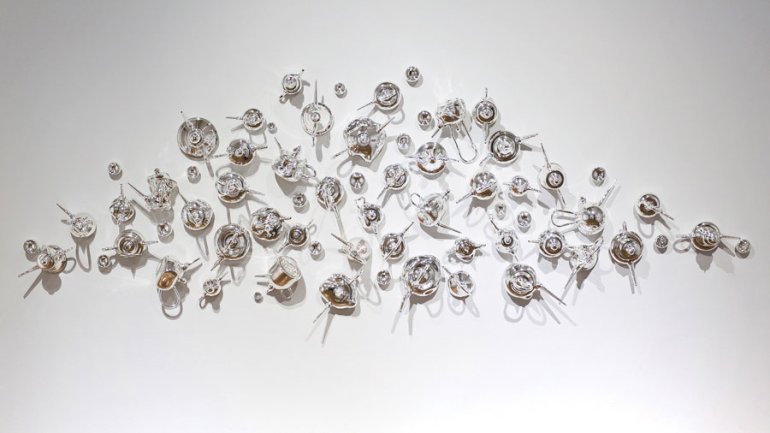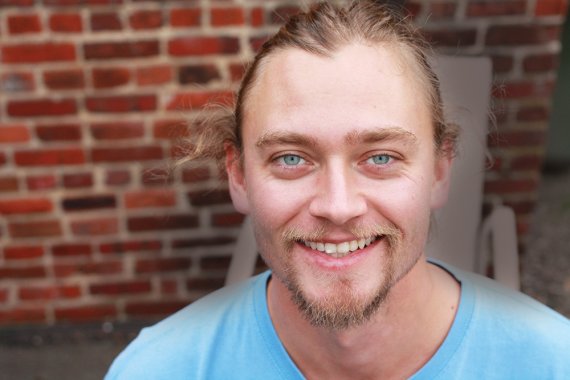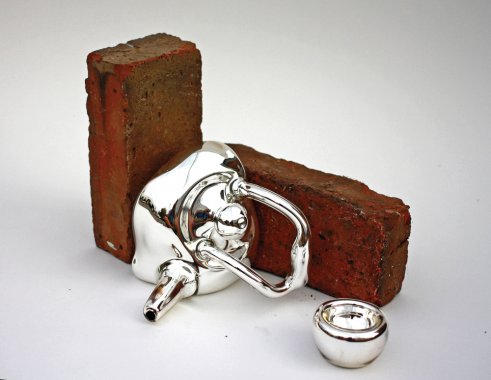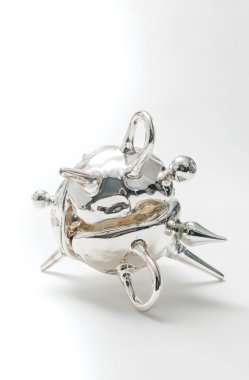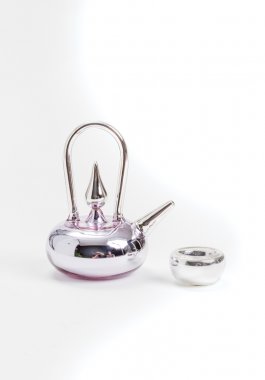Double Take
Double Take
Something’s different. What are we seeing here?
That’s the odd sensation we have when we encounter a sculptural installation by Sean Donlon. His assemblages of twisted, misshapen teapots and kettles – familiar objects in a strange context – play with perception through layers of contrast: foreground and background, sharp and blurry, hard and soft. Their mirrored surfaces reflect, refract, and distort.
But the vessels aren’t metal, as they appear to be; they’re glass. Sometimes he’ll disrupt the sleek aesthetic of his pieces by mounting them on wood, conjuring the effect of liquid pools afloat on a hard, earthy surface. Or he’ll put a teapot on the floor, squashed by a brick, in a startling juxtaposition of civility and brutality.
As in life, the mysteries and misdirection in Donlon’s art invite us to question our point of view, perhaps gain new insight. He began the teapot series in 2013, during a patch of relationship trouble coupled with illness in his family. “My whole life was that cliché of upside-down and sideways. It was a way for me to visually portray that in a literal form,” the artist says of what became a rich conceptual vein for him to mine, using a flameworking torch as his primary tool to blow and shape molten glass. Now, at 30, he’s in a happier place in every sense, working out of a collaborative space he co-founded in Richmond, Virginia. Called Mule Barn Craft Studio (a nod to its onetime function), it’s a collegial environment for a handful of makers in glass and other mediums.
From an early age, Donlon learned to look at things differently. He grew up in Virginia just outside Washington, DC, where his father worked in the State Department. His mother, a German fiber artist and jewelry maker, encouraged his creative bent. Besides equipping him with “really sharp scissors and good materials,” she enrolled him in a preschool run by the Smithsonian Institution. “I knew who Leonardo da Vinci was before I knew what my favorite color was,” Donlon recalls. From first through fourth grades, he spent half of every day in a German-language immersion program at his public school. That bilingual experience taught him to think from various angles, an approach he follows in the studio to this day. “If I start something from top to bottom, the next time I’ll try it bottom to top.”
The glass artist studied marine biology at Old Dominion University for two years, drawing, painting, and making prints in his spare time. He left school to become a full-time artist at the Workhouse studio space in northern Virginia. One day, visiting a glassblower friend in the hot shop, he watched him wield a torch. “It looked like a ray gun in a Martian cartoon. He said, ‘Here, try it.’ I made a marble, and he was like, ‘Whoa, I’ve never seen anyone just pick it up and do that.’ I showed up every single day after that.”
Donlon transferred to Virginia Commonwealth University to pursue a major in craft and material studies. He wanted to work conceptually, push the limits of the field. In 2012, he got a research grant to travel to Germany and study with a maker of prosthetic eyes. Prosthetics, in fact, have always fascinated him. When he expressed that interest in high school (prompted by another illness in the family), his guidance counselor arranged for him to visit a center for artificial limbs, an experience that helped shape his outlook on appearance and identity in ways that resonate in his artwork. “When you look in a mirror at yourself,” he says, “you want to see who you are on the inside as well. For people who’ve been through trauma, that’s an important need to fill.”
Viewers are responding to Donlon’s vision. In 2016, as a first-timer at the Visual Arts Center of Richmond’s Craft + Design show, he sold out his booth and won Best in Show. Following a busy 2017, he’s getting ready for his first solo exhibition in October, at Quirk Gallery in his home city. “The good things that have happened in my career, I didn’t plan,” he says. “I just went for it, and it worked out. Taking the bad times in my life and using them. Staying honest as to why I’m making things. And using that perception in life.”
Sean Donlon’s show at Quirk Gallery runs from October 11 to November 25.
